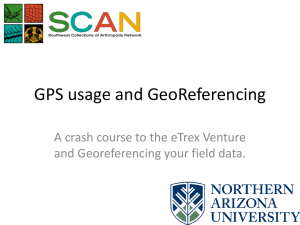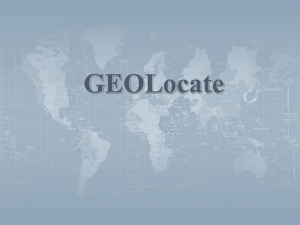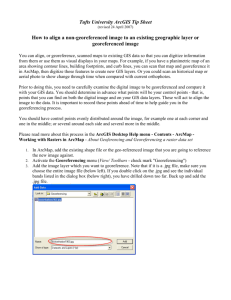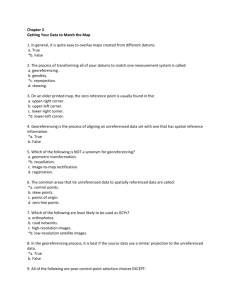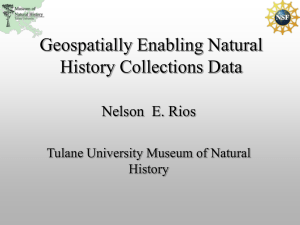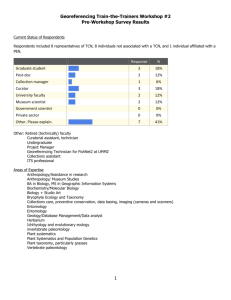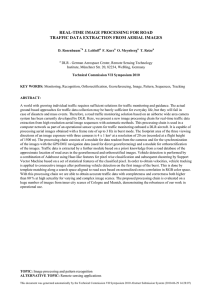DIRECT GEOREFERENCING OF TLS IN SURVEYING OF COMPLEX SITES
advertisement
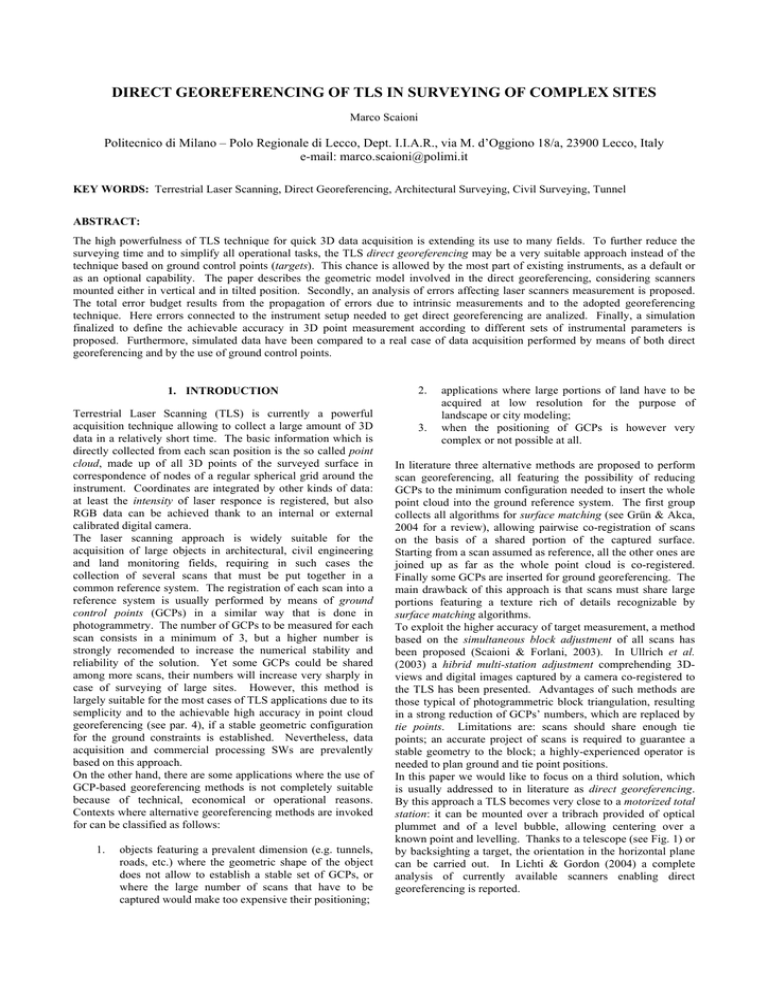
DIRECT GEOREFERENCING OF TLS IN SURVEYING OF COMPLEX SITES
Marco Scaioni
Politecnico di Milano – Polo Regionale di Lecco, Dept. I.I.A.R., via M. d’Oggiono 18/a, 23900 Lecco, Italy
e-mail: marco.scaioni@polimi.it
KEY WORDS: Terrestrial Laser Scanning, Direct Georeferencing, Architectural Surveying, Civil Surveying, Tunnel
ABSTRACT:
The high powerfulness of TLS technique for quick 3D data acquisition is extending its use to many fields. To further reduce the
surveying time and to simplify all operational tasks, the TLS direct georeferencing may be a very suitable approach instead of the
technique based on ground control points (targets). This chance is allowed by the most part of existing instruments, as a default or
as an optional capability. The paper describes the geometric model involved in the direct georeferencing, considering scanners
mounted either in vertical and in tilted position. Secondly, an analysis of errors affecting laser scanners measurement is proposed.
The total error budget results from the propagation of errors due to intrinsic measurements and to the adopted georeferencing
technique. Here errors connected to the instrument setup needed to get direct georeferencing are analized. Finally, a simulation
finalized to define the achievable accuracy in 3D point measurement according to different sets of instrumental parameters is
proposed. Furthermore, simulated data have been compared to a real case of data acquisition performed by means of both direct
georeferencing and by the use of ground control points.
1. INTRODUCTION
Terrestrial Laser Scanning (TLS) is currently a powerful
acquisition technique allowing to collect a large amount of 3D
data in a relatively short time. The basic information which is
directly collected from each scan position is the so called point
cloud, made up of all 3D points of the surveyed surface in
correspondence of nodes of a regular spherical grid around the
instrument. Coordinates are integrated by other kinds of data:
at least the intensity of laser responce is registered, but also
RGB data can be achieved thank to an internal or external
calibrated digital camera.
The laser scanning approach is widely suitable for the
acquisition of large objects in architectural, civil engineering
and land monitoring fields, requiring in such cases the
collection of several scans that must be put together in a
common reference system. The registration of each scan into a
reference system is usually performed by means of ground
control points (GCPs) in a similar way that is done in
photogrammetry. The number of GCPs to be measured for each
scan consists in a minimum of 3, but a higher number is
strongly recomended to increase the numerical stability and
reliability of the solution. Yet some GCPs could be shared
among more scans, their numbers will increase very sharply in
case of surveying of large sites. However, this method is
largely suitable for the most cases of TLS applications due to its
semplicity and to the achievable high accuracy in point cloud
georeferencing (see par. 4), if a stable geometric configuration
for the ground constraints is established. Nevertheless, data
acquisition and commercial processing SWs are prevalently
based on this approach.
On the other hand, there are some applications where the use of
GCP-based georeferencing methods is not completely suitable
because of technical, economical or operational reasons.
Contexts where alternative georeferencing methods are invoked
for can be classified as follows:
1.
objects featuring a prevalent dimension (e.g. tunnels,
roads, etc.) where the geometric shape of the object
does not allow to establish a stable set of GCPs, or
where the large number of scans that have to be
captured would make too expensive their positioning;
2.
3.
applications where large portions of land have to be
acquired at low resolution for the purpose of
landscape or city modeling;
when the positioning of GCPs is however very
complex or not possible at all.
In literature three alternative methods are proposed to perform
scan georeferencing, all featuring the possibility of reducing
GCPs to the minimum configuration needed to insert the whole
point cloud into the ground reference system. The first group
collects all algorithms for surface matching (see Grün & Akca,
2004 for a review), allowing pairwise co-registration of scans
on the basis of a shared portion of the captured surface.
Starting from a scan assumed as reference, all the other ones are
joined up as far as the whole point cloud is co-registered.
Finally some GCPs are inserted for ground georeferencing. The
main drawback of this approach is that scans must share large
portions featuring a texture rich of details recognizable by
surface matching algorithms.
To exploit the higher accuracy of target measurement, a method
based on the simultaneous block adjustment of all scans has
been proposed (Scaioni & Forlani, 2003). In Ullrich et al.
(2003) a hibrid multi-station adjustment comprehending 3Dviews and digital images captured by a camera co-registered to
the TLS has been presented. Advantages of such methods are
those typical of photogrammetric block triangulation, resulting
in a strong reduction of GCPs’ numbers, which are replaced by
tie points. Limitations are: scans should share enough tie
points; an accurate project of scans is required to guarantee a
stable geometry to the block; a highly-experienced operator is
needed to plan ground and tie point positions.
In this paper we would like to focus on a third solution, which
is usually addressed to in literature as direct georeferencing.
By this approach a TLS becomes very close to a motorized total
station: it can be mounted over a tribrach provided of optical
plummet and of a level bubble, allowing centering over a
known point and levelling. Thanks to a telescope (see Fig. 1) or
by backsighting a target, the orientation in the horizontal plane
can be carried out. In Lichti & Gordon (2004) a complete
analysis of currently available scanners enabling direct
georeferencing is reported.
At time of writing and as far as the author’s knowledge, some
data acquisition SWs encompass the possibility of direct
georeferencing, even though this is limited to a well established
procedure only. Here the geometric model involved in this task
is described and an operational method to get direct
georeferencing of scans is proposed (par. 3). Furthermore, an
analysis of error sources related to laser scanning data is
reported, so that the achievable accuracies by different methods
can be compared (par. 4). Finally a simulated test and a
practical case study concerning the surveying of an ancient
church afforded by different approaches is reported.
In par. 2 some basic fundamentals concerning reference systems
adopted in the following of the paper are given.
software for data acquisition control, which directly performs
the correction of 3D point coordinates into the IRS. In the
following we refer to spherical coordinates of a point through
the vector of measurements ρ = [ρ α θ]T. The transformation
from spherical coordinate ρ to cartesian coordinates is given by
the following equations:
x ρ ⋅ cosθ cosα
x = y = ρ ⋅ cosθ sinα
z ρ ⋅ sinθ
(1)
2.2 Ground reference system
The ground reference system (GRS) is shared between more
than one scan. To trasform each scan from its own IRS into a
GRS a 3D roto-translation is to be computed on the basis of
common control points (or features). This operation is called
scan co-registration. Given the vector X storing coordinates of
a point in the GRS, the trasformation from the IRS can be
expressed by introducing the rotation matrix R and the vector
O1 expressing the origin of the IRS with respect to the GRS:
X = Rx + O1
Fig. 1 – The scanner Riegl
LMS-Z420i equipped by
the telescope for TLS’s
azimuth direct orientation
and by the device enabling
the tilt-mounting.
2. BACKGROUND ON 3D-SCAN GEOREFERENCING
The problem of scan registration is usually addressed through
the definition of 2 reference systems (RS): the intrinsic and the
ground RS. With reference to Figure 2 they are analyzed in the
following paragraphs.
(2)
The rotation matrix R can be parameterized by cardanic angles
(ω,ϕ,κ) as commonly done in photogrammetry.
Concerning materialization of a GRS, this can be done by a set
of control points with known coordinates, or by considering a
scan as reference for co-registering all the others that overlap to
it.
Usually a GRS corresponds to a given geodetic RS. In the
architectural field, due to limitation of the survey site extension
to a few hundred meter, a local planar approximation for the
height reference surface is adopted. The resulting GRS features
the z axis aligned to the mean vertical direction in the interested
area and the xy plane orthogonal to it.
P
z
Z
ρ
2.1 Intrinsic reference system
Usually a laser scanner performs the measurement of a large
point cloud in a very short time (up to 12k points per second in
case of the fastest existing TLS). For each laser point a range
measurement (ρm) and an intensity value (I) are collected; these
data may be integrated by RGB information in case a digital
camera is co-registered to the scanner. Furthermore, the
horizontal rotation angle (αm) and the vertical attitude angle
(θm) are registered for each measured point, allowing its
determination in the intrinsic reference system (IRS) of a given
scan position. In practice, if more than one scan are captured
from the same stand-point without altering the TLS position and
attitude, all resulting 3D-views will be referred into the same
IRS.
By construction, the laser scanner axes are not perfectly
aligned, so that these differences have to be corrected in order
to transfer the measured spherical coordinates (ρm,αm,θm) into
the IRS (ρ,α,θ). The geometric model adopted to perform this
correction should be given by TLS technical documentation,
but this does not happen for all instruments. On the other hand,
each laser scanner model is usually provided by its own
IRS
y
θ
O1
α
H
x
GRS
κ
X
orientation target
Y
O2 (XO2,YO2)
Figure 2 – Ground and Intrinsic RS of a scan position.
2.3 Indirect and direct georeferencing
The term georeferencing means the computation of R and O1
for each scan position. The widespread technique to do this is
based on registering each scan to the GRS by means of a set of
GCPs materialized by targets or by natural features. Thanks to
the knowledge of a minimum of 3 GCPs that can be measured
in the scan to be georeferenced, all 6 parameters of the rototranslation can be computed by a resection technique. In
practice, the GCPs’ number should be increased in order to
push up the redundancy. Being this problem not linear, usually
an algorithm which does not require any approximations for the
unknowns is applied; in literature a large variety of these
methods are reported (see Beinat & Crosilla, 2001). To cope
with possible outliers and to automatically find corresponding
points on the scan and the ground, the RANSAC algorithm is
widely used (Fischler & Bolles, 1981). Finally, once a set of
good GCPs has been established, a least squares based
algorithm is applied to exploit the data redundancy – if
available – and to evaluate the accuracy of the estimated
solution.
Even though in literature different methods based on a block
adjustment for computing both R and O1 of each scan have
been proposed (see par. 1), their use is still very limited in
practitioners’ applications.
The second strategy to perform the scan georeferencing is that
based on the so called direct approach. The most part of
existing TLS can be directly georeferenced, meaning that the
sensor can be optically centered over a known point and
levelled, while the remaining degree-of-freedom can be fixed
by orienting the IRS system toward a known point. The last
task can be performed by using a telescope mounted on the
laser scanner or by scanning a backsighting target. In the
sequel the geometric model which is usually adopted for direct
georeferencing is presented, considering also the case of a TLS
mounted in tilted position.
The chance of success of such a method will depend obviously
on the final accuracy of 3D point cloud coordinates
measurement. To this aim, at par. 4 an analysis of errors
affecting both indirect and direct georeferencing methods is
reported.
3. GEOMETRIC MODEL FOR DIRECT
GEOREFERENCING
The simplest method to get direct georeferencing of a scan is
based on the possibility of centering the TLS over a know point
by an optical plummet, to level the instrumental basement and
to fix an horizontal direction by means of a telescope which is
calibrated with respect to the IRS. Disregarding specific
practical solutions adopted in currently available TLSs and
possible user-made improvements, here we would like to focus
on the general geometric model.
The basic geometric model describing a TLS which can be
oriented by a telescope is similar to that describing a classical
theodolite. The scanner is stationed over a known point in a
given GRS while the z axis of its own IRS is put vertical.
Being known the vector H from the stationing point to the
origin O1 of the IRS from calibration or from mechanical
drawings, coordinates of O1 in the GRS can be easily derived.
The telescope is usually blocked over the TLS scanner head and
can be rotated in the xz plane defined by the IRS. By
collimating a point O2 having planimetric known coordinates in
the GRS (XO2,YO2) also the direction of the x axis of the IRS
can be fixed and then the horizontal angle κ constrained. The
IRS will result rotated around the z axis of an angle κ with
respect to the GRS; for this reason, we refer to a generic point
in the IRS by vector xκ. The transformation from IRS to the
GRS is given by the expression:
X = R κ xκ + O1
(3)
where the rotation matrix Rκ will define the rotation κ from the
IRS to the GRS:
cos κ
R κ = sin κ
0
− sin κ
cos κ
0
0
0
1
(4)
In eq. (3) the only parameter which is still unknown is the angle
κ, that can be computed as follows:
κ = atan
YO 2 - YO1
X O 2 - X O1
(5)
Let us now introduce into the model the chance of rotating the
scanner in the vertical plane, task which can be performed by a
mechanical device enabling a tilt mounting at some fixed
angular steps (see an example in Fig. 1). This possibility is
required when the instrument has a limited vertical FoV and an
object positioned upwards has to be scanned.
We consider the new rotation φ around the y axis; only a set of
discrete values φ = {φ1, φ2,..., φn } for this angle can be setup on
the tilt-mounting device.
The order of rotations introduced so far follows the operational
procedure used for TLS backsighting by means of a telescope:
firstly the scanner is stationed in vertical position (φ=0);
secondly is rotated around the z axis in order to collimate the
backsighting target by the telescope; finally it is tilted around
the y axis.
To consider also the rotation in the vertical plane, a new matrix
Rφ is introduced:
cos φ 0 sin φ
R φ = 0
1
0
− sin φ 0 cos φ
(6)
Coordinates of a point in the IRS considering also the second
rotation (xκφ) are related to coordinate after the first rotation
only (xκ) by the expression:
xκφ = R φT xκ
(7)
Unfortunately, the introduction in eq. (3) of the value of xκ
derived from (7) is not enough for modelling what really
happens in mechanical devices for tilt-mounting, because the
rotation axis is usually not centered in the origin O1 of the IRS,
but may be shifted in x (seldom) and z direction (frequently) by
eccentricities ex and ez (see Fig. 3). Consequently eq. (7) must
be corrected by keeping into account the effect of the eccentric
rotation:
xκφ = R φT xκ + e
The eccentricity vector e is defined as follows:
(8)
e x − re cos(φ + γ )
e =
0
e z − re sin(φ + γ)
re =
e 2x
+ e 2z
; γ = atan(e z e x )
(9)
4.1 Errors in direct georeferencing
Values of ex and ez can be derived from mechanical drawings of
TLS or from scanner calibration.
Finally, by computing vector xκ from eq. (8) and by introducing
it into eq. (3), you get the new expression of the transformation
from the IRS (xφκ) to the GRS in case of tilt-mounting:
X = R κ xκ + O1 = R κ R φ ( xκφ − e) + O1 = R φκ ( xκφ − e) + O1 (10)
where Rφκ= Rκ⋅Rφ.
The proposed method still holds in case instead of sighting a
target by a telescope, the TLS allows to scan a structured target
and to adopt its estimated centroid position for the orientation
of x axis.
scanner head
z
IRS
x
o
ez
ex scanner head
rotation axis
basement
Fig. 3 – Geometric
scheme of a device
for TLS tilt-mounting
in the general case
4. ANALYSIS OF THE UNCERTAINTY IN TLS
MEASUREMENTS
The error budget arises from the analysis of all error sources
contributing to covariance propagation applied to eq. (10).
The covariance matrix CO associated to vector O1 (position of
the instrumental centre) will depend on the sum of two
covariance matrices:
CO = Cnet + CH
(11)
where expressions for matrices on the right are reported in
Table 1. In the next sub-paragraphs an analysis of errors of
(12)
Firstly the covariance matrix of the ground stationing point Cnet
must be considered; it can be taken from the adjustment of the
geodetic network. In general this matrix is not diagonal,
because in applications where direct georeferencing is applied
poor redundant network schemes are often used and coordinates
might be highly correlated. The second contribute is given by
the uncertainty of vector H expressing the relative position of
the instrumental centre with respect to the stationing point on
the ground (Fig. 2). The resulting covariance matrix CH is
diagonal, made up of variances of H’s components. In the most
cases, both planimetric components of H can be determined
with a high accuracy from instrumental drawings, considering
that errors due to centering will be deal with among setup
errors. On the contrary, the instrumental height hs must be
evaluated every time on the field, introducing an error which
cannot be negletted. A further error involving precision of
network measurements is that related to the computation of
azimuth by formula (5).
A second class of errors is that related to the instrumental setup,
grouping stand-point and orientation target optical centering,
levelling and manual point collimation to the backsight station
(or scanning of a target over a known point). All these errors
are included in the covariance matrix Cset.
The total covariance matrix of a 3D scanned point can be
computed by the variance propagation law applied to (10):
C X = C0 + J ρ (C int + Cset ) J ρT + J κ C κ J Tκ
From a general point of view, the uncertainty of a 3D point
coming from laser scanning acquisition arises from several
sources, some connected to the intrinsic measurements (i) range and angles - and the others to the adopted georeferencing
procedure (ii). This is only a rough classification, which
however may help to evaluate the final uncertainty according to
a given georeferencing method.
In reality, errors on
measurements also affect georeferencing, as happens e.g. when
a 3D resection method is used for registration, being this based
on target measurement suffering from intrinsic errors as well.
All possible error sources are briefly reported in Table 1 with
expressions for their evaluation; the contribute of each error
source is represented into a specific covariance matrix. The
approach proposed by Lichti & Gordon (2004) has been mainly
followed.
Group (i) encompasses the effect of noise in measurements and
the laser beamwidth. The total contribute of these errors is
accounted for in the covariance matrix Cint:
Cint = Cb + Cobs
group (ii) is reported according to both direct and indirect
georeferencing methods.
(13)
In formula (13) the uncertainty due to tilt-mounting angle φ and
to both eccentricities ex and ez has been negletted, because of
the high accuracy of mechanical devices currently adopted to
this aim.
Expressions of both jacobians in formula (13) are the following
for the general case of tilted mount:
cosθ cosα −ρ cosθ sinα −ρ sinθ cosα
∂X ∂xκφ
= Rφκ cosθ sinα ρ cosθ cosα − ρ sinθ sinα (14)
Jρ =
∂xκφ ∂ρ
sinθ
0
ρ cosθ
Jκ =
∂X ∂R φκ
=
( xκφ − e)
∂κ
∂κ
(15)
4.2 Errors in georeferencing by resection
When applying a resection method for computing the
georeferencing of a scan usually at least a small redundancy in
observed GCPs exists and a standard l.s. estimation is applied.
Thank to GCPs and their corresponding measured points in the
IRS, a system can be established and solved for the 6
registration parameters of each scan. Moreover, variances of
targets in object space could be introduced into the system as
pseudo-observations if their values would not be negligible.
The uncertainty of the estimated parameters is given through
the covariance matrix yielded during the l.s. procedure (Cgeo),
depending on the accuracy of targets in the IRS and possibly in
the GRS, as well as on their geometric positions (on this subject
see Gordon & Lichti, 2004).
Finally the positional uncertainty of a measured point
(covariance matrix CX) can be computed from error propagation
through eq. (3), considering as stocastic variables either the
Error source
measurements
laser beamwidth
azimuth
Uncertainty
expression (1σ)
σρ,σα,σθ
(from manufacturers
or from metrological
tests)
σ b = ±δ / 4
2σ H
σκ = ±
d O1O 2
TLS and
backsighting
target centering
instrument
levelling
σlH= ± σlV tan θ
σlV= ± 0.2 v″
pointing error by
telescope
σp =±
pointing error by
target
backsighting
σ pc
σd = ±
2σ c
d O1O 2
60′′
M
∆
=±
2 3
estimated georeferencing parameters and the scanner
measurements in vector ρ. The covariance matrix CX will
result as:
T
C X = J geo Cgeo J geo
+ J ρ C int J ρT
Meaning of parameters
Covariance matrix
σρ = uncertainty of range
σα,σθ = uncertainties of horizontal and vertical
angles
m = # of averaged measurements (multi-scan)
δ = diameter of laser cross-section in angular
units
σΗ = mean planimetric uncertainty of network
points
Cobs=diag(σρ2,σα2,σθ 2)/m
(16)
Cb=diag(0,σb2, σb2)
Cκ= [σκ2]
σc = mean centering uncertainty of a stationing
points
0
0
0
2
2
2
Cset = 0 (σ lH + σ d + σ p ) 0
σlH, σlV = uncertainties in horizontal and vertical
0
0
σ lV2
angles related to the levelling
or alternatively if the method of
v″ = level sensitivity
target backsighting has been used:
M = telescope magnification
0
0
0
2
2
2
Cset = 0 (σ lH + σ d + σ pc ) 0
∆ = angular sampling interval in both α and θ
0
0
σ lV2
Table 1 – Expressions of uncertainties of parameters involved in direct georeferencing of a TLS (from Licthi & Gordon, 2004).
4.3 Uncertainty in current practitioners’ applications
We would like here to make some considerations about
uncertainty in practical TLS surveying for civil engineering and
cultural heritage recording. In case a simulation of point cloud
accuracy is required before data capture, covariance matrices
for computing error propagation are needed. A first group of
these can be easily recovered, depending only on technical
properties of adopted hardware (i.e. levelling bubble,
backsighting telescope or target). Unfortunately, tools supplied
by vendors to enable direct georeferencing (in many case not as
default but optionally) are usually of low quality; in
applications where the highest accuracy is required, they have
to be replaced by improved user-made tools. However, the
verticality of the main instrumental axis is the major source of
error due to the fact that a dual axis compensator is not
available yet in current TLSs, even though it is commonplace
that it is becoming a standard in the future. In the context of the
present research, some trials in a calibrated test-field are
ongoing to the aim of evaluating the effective verticality error.
The accuracy of the geodetic network nodes, which directly
influences the TLS positioning through the covariance matrix
CO, is completely application-depending. In the considered
fields of application, redundant geodetic networks are seldom
adopted, due to the shape of surveyed objects or to the large
range of uncertainty which is commonly tolerated. In small
networks the adoption of homogeneous values for st.dev.s of
each vertex’s coordinates is reasonably accepted; these values
can be computed from the application of error propagation
theory or from standard tables in case of well known network
geometries (e.g. a traverse). If a more complex geodetic
network has been used, as in the acquisition of very large
settlements, values for CO could come from a l.s. simulation.
Considerations about uncertainty in range and angles
measurements have been already made at par. 4.1. According
to Lichti & Gordon (2004) and to Fröhlich & Mettenleiter
(2004), we retain that values reported in technical reports are
not enough reliable, but they should be derived from practical
on-the-field test.
5. TWO EXAMPLES
In order to evaluate the uncertainty of 3D spoints measurements
by applying different methods for scan georeferencing, we have
performed two tests. The first one concerns the simulation of
the covariance matrix of points in a typical configuration
usually adopted in laser scanning data acquisition, according to
some sets of instrumental parameters affecting the final
accuracy. In a second test, a TLS surveying of an ancient
church which was already carried out adopting georeferencing
by resection has been recomputed by the direct technique.
5.1 Simulation of 3D point uncertainty in a typical
configuration for data acquisition
Simulations have been computed by considering the geometric
configuration in Figure 4, with the instrument mounted in
vertical position and equipped by a telescope for azimuth
orientation. Accuracy has been evaluated for 3D point
coordinates in the range 12.5÷100 m of horizontal distance
from instrument stand-point; two different vertical angles have
been considered: θ1=0° and θ2=40°. Among all possible, only 6
combinations of parameters (see Fig. 5) have been tried,
according to the following criteria: to test instruments featuring
different accuracy in intrinsic measurements and laser
beamwidth (i); to consider low (sets 1-2-3) and high (sets 4-5-6)
quality tools for direct georeferencing, i.e telescope and level
bubble (ii).
M=3, v=2′
y
O1
d = 12.5÷100 m
orientation
target
x
O2
dO1O2= 30 m
Fig. 4 – Geometric
configuration for
TLS data acquisition
considered in the
simulated test
M=30, v=20″
laser
beamwidth:
0.12
mrad
σρ= ± 5
mm
σα−θ= ±
4 mgon
laser
beamwidth:
0.75
mrad
σρ=
± 10
mm
σα−θ=
± 40
mgon
laser
beamwidth:
3 mrad
σρ=
± 10
mm
σα−θ=
± 40
mgon
Legend for vertical angle θ=0°
Legend for vertical angle θ=40°
Figure 5 – Simulated coordinate accuracy from error propagation of different TLS configurations; two vertical angles for point
positions have been considered.
Concerning the remaining parameters described at par. 4, we
have established some fixed values that can be easily found in
the practise. Consequently, the accuracy of stand-points has
been fixed to ±5 mm for all coordinates, which have been
considered uncorrelated. Trying different accuracies for standpoint coordinates has been omitted in tests, because in formula
(13) the covariance matrix C0 is only an additive term and its
effect can be easily evaluated. The uncertainty of instrumental
height has been selected as σhs=±3 mm and that of stand-point
centering as σc=±1 mm.The distance between the TLS standpoint and the orientation target has been always assumed as 30
m According to the formula for evaluting σκ in Table 1, this
st.dev. is inversely proportional to the distance.
Results of tests are reported in graphics (Fig. 5) in term of 2σ
precision (95% confidence) of 3D point coordinates in function
of the horizontal distance from the scanner. In addition, the
root of the maximum eigenvalue of the covariance matrix CX is
shown, which makes this assessment independent from the
adopted GRS.
The lecture of results which is presented in the following has
been focused to assess the possibility of applying direct
georeferencing in practical applications, omitting metrological
analyses which have been already performed by the quoted
authors.
due to uncertainty of stand-point and of azimuth determination.
Improvements can be achieved by a higher precision geodetic
network and by increasing the distance between scanner and
orientation target.
In case of TLS survey for VR modeling, usually an accuracy
about ±5÷10 cm is enough, according to the size of the site. For
this kind of applications also scanner featuring configurations 2
and 3 might be applied, depending on the involved distances.
When operating in outdoor environment large distances
between scanning stations can be easily established, so that
orientation targets must be placed as far as possible from the
stand-point position to reduce the error on azimuth
determination. On the contrary, in indoor projects the only way
to reduce the uncertainty is to improve the network accuracy.
5.2 Results on a real test: the church of S. Eufemia in Erba
A 3D model of the church of S. Eufemia in Erba (Italy) has
been acquired by a Riegl LMS-Z420i instrument, equipped by
the telescope (M=3) which is sold by the manufacturer as
optional tool and by a level bubble of sensitivity v=30″.
Moreover, data capture has been carried out by measuring some
targets as well.
The use of both direct and indirect
georeferencing methods has shown some discrepancies in point
cloud measurement. Differencies along a direction orthogonal
to the surface have been estimated by comparing the surfaces of
TIN models generated from both point cloud in planar areas;
those in a parallel direction by finding a set of corresponding
features, with the help of superimposed photo-texture.
According to a maximum horizontal distance from object to
TLS of about 55 m, discrepancies in coordinates of points have
given R.M.S. in the order of 39 mm and 31 mm in the parallel
plane and 25 mm in orthogonal direction. These findings show
a similarity with respect to results of simulations for scanner
configuration 1 (Fig. 5), accounting for the difficulty of making
a comparison.
In Figure 6 the triangulated 3D model of S. Eufemia church is
reported.
5.3 Main fields of application for direct georeferencing
Architectural surveying. The use of TLS tecnique for
architectural survey can be finalized to obtain two main kinds
of products: classical drawings such as planimetric maps,
sections and prospects (i); VR 3D-models (ii). In both case the
integration to photogrammetry is mandatory, due to the difficult
interpretation of point cloud data and to the information
augmentation achievable from imagery (see Beraldin, 2004).
Applications of group (i) require accuracies in the order of
±2÷3 cm (2σ), limiting the use of direct georeferencing only to
high performance TLSs such as those in configuration 4 in Fig.
5. When operating in indoor environments, where distances
more then 20-25 m rarely appear, also instruments such that in
configuration 1 may be used. Considering the influence of
single error sources to the total budget, the major contribute is
Figure 6 – The triangulated model of a portion of the Church of
S. Eufemia in Erba (Italy) where a test on direct
georeferencing has been performed.
5.3.2
Tunnel and indoor mine survey. We mention this
specific application because here the direct georeferencing
technique is highly suitable to be successfully applied. First of
all, surveying in tunnels or mines is a very complex task due to
adverse environmental conditions; the use of laser scanner
instead of total stations might reduce the operating time, while
the engagement of the operator is limited to control laser data
acquisition and some total station measurements for geodetic
network determination and for data integration. For the same
grounds, avoiding the target positioning is a further advantage,
calling for application of TLS direct georeferencing. Moreover,
a high accuracy in 3D point coordinates is not required, due to
the roughness of surfaces and to the aims of surveying, which
are geometric modelling for static computation, design of
protection structures, evaluation of excavated volumes,
vizualization of dismissed mines for touristic and teaching
purposes.
A point acquisition featuring an accuracy of about ±10 cm is
enough for the most of applications. Considering that distances
from the scanner inside a mine or tunnel are usually very small
(max 15÷20 m), every kind of TLS configuration in Figure 5
could be adopted.
To completely exploit the potential of TLS techniques, an
instrument featuring a horizontal panoramic FoV and a vertical
semi-panoramic FoV will further reduce the acquisition time.
Example of such instruments are Leica HDS 3000 (360°x270°
in two windows) and HDS 4500 (360°x320°), IQSun
(360°x320°), VisImage (360°x270°), Zoller+Fröhlich IMAGER
5003 (360°x320°).
A more detailed analysis about this kind of applications can be
found in Alba et al. (2005).
5.3.3 Road surveying. In this application the high operating
speed, the mean accuracy in surface measurement (about ±5÷10
cm) and the possibility of integrating geometric data to imagery
for a better interpretation of the derived model makes the laser
scanner technique very suitable.
Also in this case all
instrumental configurations in Figure 5 may be used, according
to the involved distances usually limited to 30÷40 m. It seems
to be very promising the idea to equipe a mobile mapping
vehicle by a laser scanner. Talaya et al. (2004) presented a
vehicles where the scanner was integrated to a GPS/IMU
system which allows to direct georeferencing each line scan
when moving. The TLS is transformed so that in a line
pushbroom scanner which is able to acquire measurements with
an accuracy of ±20÷30 cm. We would like to propose a simpler
solution, which however will improve the accuracy of 3D point
measurement: the TLS is mounted on a mobile mapping vehicle
and calibrated but not integrated to the GPS/IMU; when a road
to be surveyed is reached, the vehicle is stopped and the data
acquisition is started. Thank to the stationing time of a few
minutes, more than one GPS epoques can be processed so that
the positioning might reach a higher accuracy. The azimuth
may be derived from the yaw angle measured by the IMU
sensor or by installing a couple of GPS receivers.
6. FINAL CONSIDERATIONS
In the paper a background about direct TLS georeferencing has
been presented, concerning either the geometric model for a
general scanner mounting (also tilted) and the analysis of the
whole error budget.
Some simulated and real tests have been carried out in order to
evaluate the accuracy in data acquisition according to different
sets of instrumental parameters. For each configuration, the
accuracy of 3D point coordinate measurements has been
evaluated as function of the distance from the scanner.
The first consideration is that the high performances reported
by TLSs’ vendors must be accurately verified, especially when
using direct georeferencing. An accurate design of the
surveying geometry is required, involving the need of highly
skilled operators.
Nevertheless, some fields of applications exist where the use of
direct georeferencing techniques seems to be very promising.
These collect all cases where a relative medium-low accuracy
in 3D point measurement, a rapidity of the surveying operations
and the difficulty of target positioning are strictly required. We
consider that the survey of architectural indoor environments,
of tunnel, mines and roads as well as the data acquisition for
VR modeling are applications where direct technique might
give more fruitfull results in the near future.
Moreover, further investigations finalized to setup standard
configurations for TLS data acquisition in such cases should be
established, so that a large group of operators might afford with
success these kinds of applications.
REFERENCES
References from Journals:
Fischler, M.A., and R.C. Bolles, 1981. Random Sample
Consensus: a Paradigm for Model Fitting with Applications to
Image Analysis and Automated Cartography. Comm. ACM, n.
24, pp. 381-395.
Gordon, S.J., and D.D. Lichti, 2004. Terrestrial laser scanners
with a narrow field of view: the effect on 3D resection
solutions. Survey Review, Vol. 37(292), 22 pp..
References from Other Literature:
Alba, M., Giussani, A., Roncoroni, F., and M. Scaioni, 2005.
Strategies for Direct Georeferencing of Riegl LMS-Z420i Data.
In printing in Proc. of Optical 3D Measurement Techniques VII,
Vienna, Austria, 3-5 Oct.
Beinat, A., and F. Crosilla, 2001. Generalised Procrustes
Analysis for Size and Shape 3-D Object Reconstructions. In
Proc. of Optical 3D Measurement Techniques V, Vienna,
Austria, 1-4 Oct, pp. 345-353.
Beraldin, J.A., 2004. Integration of Laser Scanning and CloseRange Photogrammetry – The Last Decade and Beyond.
IAPRSSIS, Vol. 35(B7), Istambul, Turkey, pp. 972-983.
Fröhlich, C., and M. Mettenleiter, 2004. Terrestrial Laser
Scanning – New Perspectives in 3D Surveying. IAPRSSIS, Vol.
36(8W2), Freiburg, Germany, pp. 7-13.
Grün, A., and D. Akca, 2004. Least Squares 3D Surface
Matching. IAPRSSIS, Vol. 34(5/WG16), Dresden, Germany, on
CDROM.
Lichti, D.D., and S.J. Gordon, 2004. Error Propagation in
Directly Georeferenced Terrestrial Laser Scanner Point Clouds
for Cultural Heritage Recording. In Proc. of FIG Working
Week, Athens, Greece, May 22-27, pp. 16.
Scaioni, M., and G. Forlani, 2003. Independent Model
Triangulation of Terrestrial Laser Scanner Data. IAPRSSIS,
Vol. 34 (5/W12), Ancona Portonovo, Italy, pp. 308-313.
Talaya, J., Alamus, R., Bosch, E., Serra, A., Kornus, W., and A.
Baron, 2004. Integration of a Terrestrial Laser Scanner with
GPS/IMU Orientation Sensors. IAPRSSIS, Vol. 35(5), Istambul,
Turkey,on DVD.
Ullrich, A., Schwarz, R., and H. Kager, 2003. Using Hybrid
Multi-Station Adjustment for an Integrated Camera LaserScanner System. In Proc. of Optical 3D Meas. Tech. VI, Zurich,
Switzerland, pp. 298-304.
